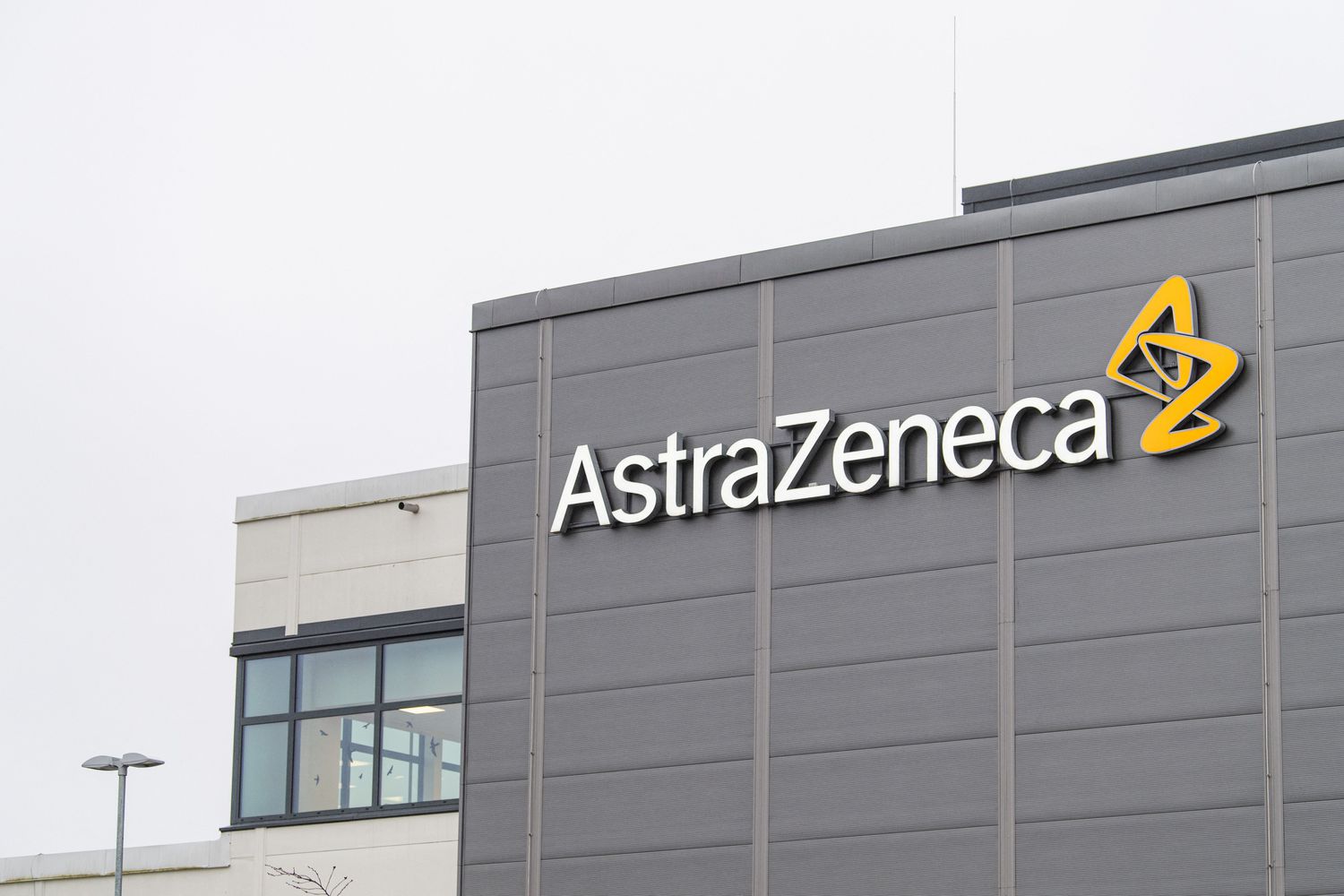AstraZeneca plc, a name synonymous with innovation and progress in healthcare, stands tall as a global Anglo-Swedish multinational pharmaceutical and biotechnology company. Formed in 1999 through the strategic merger of Astra (UK) and Zeneca (Sweden), this powerhouse has its headquarters nestled within the Cambridge Biomedical Campus in the United Kingdom. Driven by a relentless pursuit of scientific advancement and a deep commitment to patient well-being, AstraZeneca continues to carve its name at the forefront of the healthcare landscape.
AstraZeneca’s commitment to scientific exploration translates into a robust portfolio of life-changing medicines. The company’s focus extends across a wide spectrum of therapeutic areas, including oncology (cancer), cardiovascular (heart and blood vessels), gastrointestinal (digestive system), infection, neuroscience (brain and nervous system), respiratory (breathing), and inflammation. This diverse offering empowers healthcare professionals to effectively manage a multitude of critical health conditions, ultimately improving patient outcomes and enhancing quality of life.
AstraZeneca’s influence transcends its impressive product portfolio. The company actively engages in groundbreaking research and development initiatives, collaborating with leading institutions and researchers to push the boundaries of medical science. This dedication is evident in their numerous contributions to global health, most notably the development and distribution of the Oxford-AstraZeneca COVID-19 vaccine. This life-saving contribution during the global pandemic solidified AstraZeneca’s position as a champion of public health and a responsible corporate citizen.

AstraZeneca remains steadfast in its pursuit of excellence, constantly striving to develop innovative therapies, improve access to healthcare, and foster a culture of sustainability. The company’s commitment to environmental, social, and governance (ESG) principles underscores its dedication to creating a positive impact on the world beyond the realm of medicine. By leveraging its vast resources and expertise, AstraZeneca actively pursues partnerships with governments, healthcare organizations, and non-profit entities to address critical healthcare challenges and contribute to a healthier future for all.
AstraZeneca’s journey is a testament to the power of innovation, collaboration, and a unwavering commitment to improving human health. Throughout its history, the company has consistently delivered groundbreaking solutions, addressing critical medical needs and continuously raising the bar in the healthcare landscape. As it navigates the ever-evolving world of medicine, AstraZeneca remains dedicated to shaping a healthier tomorrow, one life-changing discovery at a time.
Marketing Strategies of AstraZeneca
AstraZeneca not only boasts a diverse portfolio of life-saving medicines but also employs strategic marketing approaches to reach healthcare professionals, patients, and the broader public. Understanding these strategies offers valuable insights into how AstraZeneca navigates the competitive healthcare landscape –
1. Product Portfolio Management
AstraZeneca leverages Product Portfolio Management (PPM) as a crucial element of its marketing strategy. This comprehensive approach involves strategically selecting, developing, launching, and managing its vast portfolio of pharmaceuticals to maximize patient impact and business success. Through PPM, AstraZeneca prioritizes investments in high-potential drug candidates, optimizing resource allocation and ensuring a steady stream of innovative medications.
Furthermore, PPM allows AstraZeneca to proactively manage existing products throughout their lifecycle. This includes identifying new treatment applications, expanding market reach, and maximizing the value of established drugs. By continuously evaluating and optimizing its product portfolio, AstraZeneca ensures it remains competitive and delivers life-changing medicines to patients across the globe.
Ultimately, PPM serves as a cornerstone of AstraZeneca’s marketing strategy, enabling them to deliver on their mission of pushing the boundaries of science for the benefit of patients around the world. Their commitment to responsible product portfolio management underscores their dedication to innovation, accessibility, and patient-centric healthcare solutions.
2. Research and Development (R&D) Focus
AstraZeneca prioritizes research and development (R&D) to discover and develop groundbreaking therapies and vaccines, addressing crucial unmet medical needs. This commitment is evident in their extensive pipeline of potential new products, showcasing promising candidates in various clinical development stages.
Focusing on three key areas, AstraZeneca’s R&D strategy tackles critical areas:
- Oncology: They possess a comprehensive oncology program targeting a wide range of cancers, effectively addressing unmet needs.
- Cardiovascular, Renal and Metabolism (CVRM): Their focus lies in developing innovative medicines for the treatment and prevention of these specific diseases.
- Respiratory and Autoimmunity: New medicines are being developed to combat both respiratory and autoimmune diseases.
This R&D strategy extends beyond internal efforts, leveraging a global network of research centers and collaborations with leading academic institutions and biotechnology companies. AstraZeneca further embraces open innovation, actively seeking partnerships to accelerate new medicine discovery and development.
By prioritizing R&D, AstraZeneca crafts a powerful marketing strategy. Their potential new product pipeline lays a strong foundation for future growth. This dedication also sets them apart from competitors, solidifying their position as a leader within the pharmaceutical industry.
3. Global Marketing Campaigns
AstraZeneca leverages a robust, multi-faceted marketing strategy to connect with diverse audiences. They focus on five key areas – Brilinta, Diabetes, Oncology, Respiratory, and Cardiovascular – tailoring campaigns to reach healthcare professionals, patients, and caregivers.
Their multi-channel approach leverages various media platforms. Traditional methods like television, radio, and print blend seamlessly with digital avenues like social media, email, and search engine marketing. Creative formats like videos, infographics, and interactive content further enhance audience engagement.
Past campaigns demonstrate the effectiveness of this strategy. The “Your Heart Matters” campaign (2010) successfully raised awareness of heart disease and patient-doctor communication, reaching over 1 million people and generating over 1 million media impressions. Similarly, the “Breathe Better” campaign (2012) tackled asthma awareness and management, reaching over 5 million and generating over 5 million media impressions.
Constant evolution defines AstraZeneca’s marketing approach. Embracing the latest technologies and techniques ensures campaign effectiveness for reaching target audiences. Additionally, local marketing campaigns cater to specific regions and audiences, ensuring their unique needs are addressed. Through these comprehensive strategies, AstraZeneca effectively connects with the world, driving growth and awareness across its key areas.
4. Healthcare Professional Outreach
AstraZeneca prioritizes building strong relationships with healthcare professionals (HCPs) through its Healthcare Professional Outreach (HPO) strategy, a cornerstone of their marketing efforts. This strategy aims to educate HCPs about their products and services, influencing their prescribing decisions for optimal patient care.
HCPs hold immense power as “gatekeepers” to patients, ultimately determining the medications and treatments prescribed. By fostering positive relationships with HCPs, AstraZeneca ensures their products are considered during crucial patient care decisions, potentially impacting sales and market share.
Beyond relationship building, HPO focuses on educating HCPs about AstraZeneca’s offerings. Recognizing the need for HCPs to stay updated on the latest advancements, AstraZeneca utilizes various channels like medical journals, clinical trials, and educational events to equip them with comprehensive knowledge about their products and services. This empowers HCPs to make informed decisions, ultimately benefiting patient care.
AstraZeneca’s HPO strategy, encompassing diverse tactics like sales representative meetings, educational webinars, and access to valuable data, has proven successful. This approach has not only strengthened relationships with HCPs but also contributed to increased sales and a stronger market position for the company.
5. Collaborations and Partnerships
AstraZeneca embraces collaborations and partnerships built on trust and transparency. These partnerships serve three main purposes: accessing cutting-edge science, fostering innovation, and accelerating the delivery of life-changing medicines.
AstraZeneca’s collaborations encompass diverse entities. Examples include co-development and commercialization partnerships with pharmaceutical companies like Daiichi Sankyo and Merck. They also collaborate with organizations like Cellectis, a biotechnology company, to accelerate development of novel therapies. Notably, their partnership with the University of Oxford played a crucial role in the global fight against COVID-19 through vaccine development.
Beyond pharmaceutical companies and universities, AstraZeneca collaborates with a broader ecosystem. Partners like the World Wide Fund for Nature Sweden, the Cambridge Institute for Sustainability Leadership, and the Circular Bioeconomy Alliance demonstrate their commitment to environmental sustainability and responsible practices within the industry. These collaborations not only benefit their core business but also contribute to broader societal goals.
By collaborating with diverse entities across various fields, AstraZeneca leverages expertise and resources, fostering innovation and accelerating the delivery of life-saving treatments, ultimately strengthening their market position and contributing to positive societal impact.
6. Market Access Strategies
AstraZeneca prioritizes ensuring equitable access to healthcare for patients worldwide through a multi-pronged market access strategy. This strategy focuses on their five key growth platforms and leverages various approaches.
Firstly, they are actively expanding opportunities for specific medications like Brilinta, projected to reach $3.5 billion in 2023, through ongoing clinical studies. Similarly, in the diabetes sector, they collaborate with BMS to become a leader in the non-insulin market and invest in emerging markets, particularly China, offering significant growth potential.
Secondly, they are maximizing the reach of their existing respiratory portfolio through strategic marketing measures while accelerating the development pipeline for future respiratory medications. This ensures a consistent flow of innovative treatment options for patients.
Thirdly, AstraZeneca prioritizes growth in emerging markets, with China presenting the largest single opportunity. Tailored strategies target these markets to address specific healthcare needs and expand access to their products.
Additionally, they address the critical area of rare diseases by providing medications through patient support and expanded access programs. This demonstrates their commitment to offering treatments for patients with these often-neglected conditions and actively expanding availability across geographical boundaries.
Beyond these specific initiatives, AstraZeneca actively promotes diversity in clinical trials. This ensures their medications’ safety and efficacy are well-understood for all potential patient populations. Additionally, they have implemented successful access strategies in various countries like Sri Lanka, demonstrating commitment to equitable pricing and accessibility in diverse settings.
Overall, AstraZeneca’s market access strategies go beyond simply selling medications. Their focus on equitable access and patient well-being sets them apart as a responsible and patient-centric pharmaceutical company.
7. Regulatory Compliance
AstraZeneca prioritizes adhering to stringent regulatory frameworks, upholding ethical standards, and fostering a culture of compliance across its operations. This commitment translates into a multifaceted approach encompassing several key elements.
Firstly, AstraZeneca rigorously adheres to all global laws and regulations governing the registration and reporting of research studies. They also comply with relevant international codes and standards throughout the lifecycle of their products, from development and licensing to manufacturing and distribution. This ensures the safety, efficacy, and quality of their offerings.
Secondly, AstraZeneca maintains a robust privacy framework. This framework leverages dedicated personnel, processes, and technology to manage and mitigate privacy risks associated with data collection and use, safeguarding the privacy of all stakeholders.
Thirdly, AstraZeneca upholds the highest ethical standards. They operate under the principle of collaborating solely with entities who share and uphold ethical values aligned with their own.
Finally, specifically within the US, AstraZeneca has established a comprehensive compliance program. This program focuses on two crucial objectives: preventing, detecting, and correcting any unlawful conduct and fostering a workplace culture that actively promotes ethical conduct and compliance with all applicable laws.
By implementing these comprehensive marketing strategies, AstraZeneca aims to effectively communicate the value of its products, foster trust with stakeholders, and contribute to improved patient outcomes. It demonstrates the company’s commitment to not only developing innovative medicines but also ensuring their accessibility and responsible promotion within the healthcare ecosystem.
Marketing Mix of AstraZeneca
AstraZeneca leverages the 4Ps of marketing to effectively reach healthcare professionals, patients, and stakeholders. Let’s delve into each element in detail:
1. Product
Extensive Portfolio: AstraZeneca boasts a diverse portfolio of prescription drugs and vaccines across therapeutic areas like oncology, cardiovascular, renal and metabolic, respiratory and immunology, and neuroscience.
Focus on Innovation: They prioritize research and development (R&D), continuously striving to develop novel therapies and address unmet medical needs. This focus fosters a strong pipeline of potential new products, building excitement and anticipation in the market.
Life-cycle Management: AstraZeneca proactively manages existing products through brand extensions, new formulations, and lifecycle management strategies. This ensures products remain relevant and competitive throughout their market lifespan.
Emphasis on Differentiation: They strive to differentiate their products through unique mechanisms of action, improved efficacy or safety profiles, and targeted patient populations. This distinction is crucial in a crowded pharmaceutical market.
2. Price
Value-Based Pricing: AstraZeneca often employs value-based pricing, where the price reflects the therapeutic benefit a drug offers to patients. This approach aligns with their focus on improving patient outcomes and healthcare system efficiency.
Negotiation and Rebates: They engage in negotiations with governments, insurers, and healthcare institutions to ensure their products are accessible and affordable for patients. This can involve rebates, discounts, and tiered pricing structures based on patient demographics or disease severity.
Balancing Affordability and Innovation: Striking a balance between affordability and recovering the significant costs of R&D is crucial. AstraZeneca seeks to ensure their pricing strategies are sustainable while offering patients access to the latest medical advancements.
3. Place
Global Reach: AstraZeneca operates in over 100 countries, making their products accessible to a vast patient population. This requires a complex distribution network involving wholesalers, distributors, pharmacies, and hospitals.
Targeted Distribution Channels: They utilize different distribution channels depending on the product type and target audience. For example, oncology drugs may be primarily distributed through specialized oncology pharmacies, while over-the-counter medications might be available in general retail stores.
Regulatory Compliance: Navigating the intricate web of regulations governing pharmaceutical products across different countries is essential. AstraZeneca has dedicated teams ensuring compliance with local regulations and ethical guidelines throughout the supply chain.
4. Promotion
Ethical Marketing Practices: AstraZeneca adheres to strict ethical principles and regulatory guidelines regarding pharmaceutical marketing. They avoid direct-to-consumer advertising and focus their communication on healthcare professionals and patients through targeted channels.
Educational Outreach: They invest in educational programs and initiatives to inform healthcare professionals and patients about their products and disease areas. This includes scientific conferences, webinars, patient support programs, and educational materials.
Building Relationships: AstraZeneca cultivates strong relationships with key stakeholders like healthcare professionals, patient advocacy groups, and government agencies. This fosters trust and collaboration, ultimately contributing to better patient care.
Digital Marketing: They embrace digital marketing channels like websites, social media platforms, and targeted online advertising to reach specific healthcare professional and patient segments. This allows for dissemination of information, fostering patient engagement and building brand awareness.
Partnership and Collaboration: AstraZeneca actively seeks partnerships and collaborations with other pharmaceutical companies, academic institutes, and research organizations. This allows them to share resources, expertise, and accelerate the development and commercialization of new therapies.
Corporate Social Responsibility: They demonstrate corporate social responsibility through initiatives addressing global health challenges, access to medication in underserved communities, and environmental sustainability. This fosters a positive brand image and aligns with their commitment to patient well-being and healthcare equity.
By meticulously tailoring these 4Ps to their specific target audiences and market contexts, AstraZeneca strives to deliver life-changing medicines to patients while maintaining a sustainable and responsible business model.
Also Read: Marketing Strategy and Marketing Mix of Abbott Laboratories
To read more content like this, subscribe to our newsletter
Go to the full page to view and submit the form.


